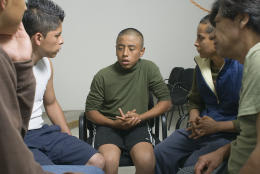
|  |  |  Editorials | Issues | October 2009 Editorials | Issues | October 2009  
Mexico Confronting a Drug Addiction Epidemic
 Dudley Althaus - Houston Chronicle Dudley Althaus - Houston Chronicle
go to original
October 05, 2009


| | Residents of the municipally run Addiction Treatment Center in Ciudad Nezahualcoyotl express their feelings and concerns at a weekly communication session. (Keith Dannemiller/Chronicle) |  |
Ciudad Nezahualcoyotl, Mexico — Tangled in the front line trenches of Mexican President Felipe Calderon's anti-narcotics campaign are the country's growing legions of addicts, who find themselves sought by gangsters as both customers and sometime targets of their violence.

Cheap and plentiful narcotics have flooded the country as producers and traffickers have sought to open new markets for cocaine, heroin, methamphetamine and other drugs.

And the gangland violence, which has killed thousands, also has targeted addicts and rehab workers: At least 43 in the last 13 months have been murdered in attacks on drug rehab centers in Ciudad Juarez, bordering El Paso.

After years of cracking down on gangsters, Calderon has turned at least some attention to prevention and treatment. Using money seized from drug traffickers, his administration in the past year has opened more than 300 new drug rehab centers, some located in small farm towns.

U.S. shifts resources

That growing focus on treatment dovetails with that of the Obama administration, which has shifted more resources to prevention and treatment as well. U.S. officials are providing Mexico with treatment techniques and helping set up so-called drug courts here in which offenders are offered supervised rehabilitation instead of jail time.

“Things that the Mexican government wants and asks for we are very happy to provide,” Thomas McLellan, the new deputy U.S. drug czar, said during a visit to Mexico City last week. “It's in our interest to do so.”

‘A consumer country'

Physician Francisco Ra- mirez is director of a municipal rehab center in Nezahualcoyotl, a onetime slum turned working class city of about 1.5 million people stapled to the eastern edge of Mexico's capital.

His center is one of more than 1,700 that have sprung up nationwide as narcotics abuse — and addiction — exploded in the past decade.

“Mexico used to be a transit place, the trampoline. Now it's a consumer country,” he said. “The drug of choice here is cocaine,” he said. “It's easier to buy crack here than it is marijuana.”

Officials estimate that 3.5 million Mexicans have used narcotics at least once and that nearly 600,000 have become dependent drug consumers.

While still a fraction of those in the U.S., where experts estimate 22 million people are narcotic-dependent, Mexico's addicts have nearly doubled in number in just five years, officials say.

“Friends consume, parents consume, brothers consume,” German Hernandez, one of four staff psychologists at the Nezahualcoyotl center said. “It's become a cultural issue.”

Senior citizens and children as young as 11 have been treated at the clinic.

Last week, six youngsters and four older family men sat semi-circled in a light-filled meeting room in the clinic discussing how to communicate with one another, their families and friends. One was 22-year-old Javier Altamirano, addicted to crack at the age of 14.

3% of addicts treated

His crack habit got him thrown out of the army, ended his marriage and separated him from his toddler son — the addiction taking nearly every peso he's able to scrape together washing cars.

“It's become that I work just to buy crack,” said Altamirano, who checked himself into the center two weeks ago vowing to break the addiction for good. “I want to have a relationship with my son. I want to have a relationship with another woman. I want to get ahead.”

Altamirano stands among only 3 percent of drug addicts being treated in Mexico, estimates the federal government's anti-narcotics office, CONADIC. Still, the odds of recovery are against him.

Opened three years ago, the Nezahualcoytl clinic has been recognized as one of the best of its kind in Mexico. But only one in three of the patients treated have been able to kick their habit for good, Ramirez said.

“They haven't taken advantage of everything we can do,” Ramirez said.

“You don't need to have a cure to have a substantial impact on the course of an epidemic.”

dudley.althaus(at)chron.com |

 |
|  |



